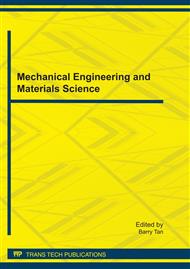[1]
G. Cheng, The analysis of active ingredients from Eucommia ulmoides and its pharmacological research progress, Chinese Traditional Patent Medicine, vol. 28, pp.723-725, May (2006).
Google Scholar
[2]
L. F. Luo, W. H. Wu, Y. J. Zhou, J. Yan, G. P. Yang, D. S. Ouyang,. Antihypertensive effect of Eucommia ulmoides Oliv. extracts in spontaneously hypertensive rats, Journal of Ethnopharmacology, vol. 129, pp.238-243, (2010).
DOI: 10.1016/j.jep.2010.03.019
Google Scholar
[3]
C. -Y. Kwan, C. -X. Chen, T. Deyama, S. Nishibe, Endothelium-dependent vasorelaxant effects of the aqueous extracts of the Eucommia ulmoides Oliv. leaf and bark: implications on their antihypertensive action, Vascular Pharmacology, vol. 40, pp.229-235, (2003).
DOI: 10.1016/j.vph.2003.09.001
Google Scholar
[4]
H. Y. Kim, B. H. Moon, H. J. Lee, D. H. Choi, Flavonol glycosides from the leaves of Eucommia ulmoides O. with glycation inhibitory activity, Journal of Ethnopharmacology, vol. 93, pp.227-230, (2004).
DOI: 10.1016/j.jep.2004.03.047
Google Scholar
[5]
M. K. Lee, M. J. Kim, S.Y. Cho, S. A. Park, K. K. Park, U. J. Jung, H. M. Park, M.S. Choi, Hypoglycemic effect of Du-zhong (Eucommia ulmoides Oliv. ) leaves in streptozotocin-induced diabetic rats, Diabetes Research and Clinical Practice, vol. 67, pp.22-28, (2005).
DOI: 10.1016/j.diabres.2004.05.013
Google Scholar
[6]
X. Jin, K. Amitani, Y. Zamami, S. Takatori, N. Hobara, N. Kawamura, T. Hirata, A. Wada, Y. Kitamura, H. Kawasaki, Ameliorative effect of Eucommia ulmoides Oliv. leaves extract (ELE) on insulin resistance and abnormal perivascular innervation in fructose-drinking rats, Journal of Ethnopharmacology., vol. 128, pp.672-678, (2010).
DOI: 10.1016/j.jep.2010.02.019
Google Scholar
[7]
M. Y. Hung, T. Y. C. Fu, P. H. Shih, C. P. Lee, G. C. Yen, Du-Zhong (Eucommia ulmoides Oliv. ) leaves inhibits CCl4-induced hepatic damage in rats, Food and Chemical, vol. 44, pp.1424-1431, (2006).
DOI: 10.1016/j.fct.2006.03.009
Google Scholar
[8]
R. Zhang, Z.G. Liu, C. Li, S.J. Hu, L. Liu, J.P. Wang, Q.B. Mei, Du-Zhong (Eucommia ulmoides Oliv. ) cortex extract prevent OVX-induced osteoporosis in rats, Bone, vol. 45, pp.553-559, (2009).
DOI: 10.1016/j.bone.2008.08.127
Google Scholar
[9]
Y. Q. Zhou, M. Liang, W. Li, K. Li, P. Li, Y. Z. Hu, Z. L Yang, Protective effects of Eucommia ulmoides Oliv. bark and leaf on amyloid β-induced cytotoxicity, Environmental Toxicology and Pharmacology, vol. 28, pp.342-349, (2009).
DOI: 10.1016/j.etap.2009.05.012
Google Scholar
[10]
Yang, J., Kato, K., Noguchi, K., Dairaku, N., Koike, T., Iijima, K., Imatani, A., Sekine, H. i, Ohara. S., Sasano, H., Shimosegawa, T., 2003. Tochu (Eucommia ulmoides) leaf extract prevents ammonia and vitamin C deficiency induced gastric mucosal injury. Life Sciences. 73, 3245-3256.
DOI: 10.1016/j.lfs.2003.06.011
Google Scholar
[11]
Horii, Y., Tanida, M., Shen, J., Hirata, T., Kawamura, N., Wada, A., Nagai, K., 2010. Effects of Eucommia leaf extracts on autonomic nerves, body temperature, lipolysis, food intake, and body weight. Neuroscience Letters. 479, 181-186.
DOI: 10.1016/j.neulet.2010.05.030
Google Scholar
[12]
G. M. Fu, Y. Wan, J. B. Zhou, Comparison of Methods of Determining the Content of Flavonoids in Extracts from Evcommia Vlmoides Oliv. Leaves, Journal of Chinese Institute of Food Science and Technology, vol. 1, pp.224-229, (2006).
Google Scholar
[13]
12. L. X. Liu, T. Laura, X. F. Liang, Y. Sun, H. Sun, X. X. Zeng, Journal of Tea Science, Determination of the Total Content of Polyphenols in Kudincha by Folin-Ciocalteu Colorimetry, vol. 2, pp.101-106, (2008).
Google Scholar
[14]
J. Wang, S. S. Li, Y. Y. Fan, Y. Chen, D. Liu, H. R. Cheng, X. G. Gao, Y.F. Zhou, Anti-exercise fatigue activity of the water-soluble polysaccharides isolated from Panax ginseng C. A. Meyer, Journal of Ethnopharmacology, vol. 130, pp.21-423, (2010).
DOI: 10.1016/j.jep.2010.05.027
Google Scholar
[15]
C. X. Yang, W. J. Zhai, Study 011 Anti-exercise fatigue Effect of Extract from Eucommia ulmoides Oliver Leaves, Food Science, vol. 29, pp.550-552, (2008).
Google Scholar
[16]
L. J. You, M. M. Zhao, J. M. Regenstein, J. Y. Ren, In vitro antioxidant activity and in vivo anti-exercise fatigue effect of loach (Misgurnus anguillicaudatus) peptides prepared by papain digestion, Food Chemistry, vol. 124, pp.188-194, (2011).
DOI: 10.1016/j.foodchem.2010.06.007
Google Scholar
[17]
M. Ikeuchi, T. Koyama, J. Takahashi, K. Yazawa, Effects of Astaxanthin Supplementation on Exercise-Induced Fatigue in Mice, Biological and Pharmaceutical Bulletin, vol. 29, pp.2106-2110, (2006).
DOI: 10.1248/bpb.29.2106
Google Scholar
[18]
M. B. Reid, Free radicals and muscle fatigue: Of ROS, canaries, and the IOC, Free Radical Biology and Medicine, vol. 44, pp.169-179. (2008).
DOI: 10.1016/j.freeradbiomed.2007.03.002
Google Scholar


